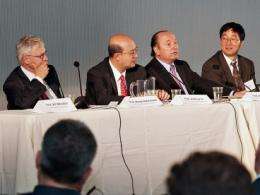Beyond the bubble: Economists contemplate ways to make the risks of financial innovation more evident

Financial bubbles cannot necessarily be prevented, but their impact can be limited by giving market participants better information about investment risks, finance experts said Friday during a panel discussion at the 25th-anniversary conference of MIT’s Center for Real Estate.
Real estate has been in the middle of the current economic crisis, since the aggregation of home loans into mortgage-backed securities provided the financial instrument through which investment banks and other firms lost hundreds of billions of dollars. The mortgage meltdown forced a costly government bailout and led to passage of the Dodd-Frank financial-reform bill, which became law in July.
But several economists took the position that bubbles fueled by borrowing are the price we pay for having active markets, and suggested it was unrealistic to expect regulation to prevent future bubbles.
“Leverage propels growth,” said William Wheaton, the director of The Center for Real Estate, while moderating the session on “Financial Re-Engineering.” The bigger problem, Wheaton said, is that “we don’t always have a very good handle” on the risks that heavy borrowing poses for the whole economy.
While some economists recognized the overinflation of the housing market as it occurred, the need to better understand systemic risk — the way a bubble can create widespread economic problems due to financial practices — is why Andrew Lo, director of the Laboratory for Financial Engineering at the MIT Sloan School of Management, said he was enthusiastic about a part of the Dodd-Frank reform that creates a new Office of Financial Research, intended to make public timely economic and market data. Lo suggested the new office might develop into finance’s equivalent of the National Transportation Safety Board, which investigates transportation accidents.
“Having an independent body that analyzes and sifts through the wreckage … is an incredibly important dynamic that’s made air travel a lot safer now than in previous decades,” said Lo. The financial equivalent would produce credible public research clarifying the implications of new financial practices in a globally interconnected economy.
Robert C. Merton, the MIT Sloan School of Management Distinguished Professor of Finance, said he had advocated the idea of an Office of Financial Research while the Dodd-Frank bill was being written. An independent body outlining risks, Merton suggested, would force market participants to look more closely at their own activities.
That is especially important, Merton suggested, because in contemporary finance, apparently loosely connected practices and conditions can combine to create massive problems. Lo and Merton released a working paper last year (co-authored by Amir Khandani, a post-doctoral student at the MIT Sloan School of Management) analyzing how three trends that can each be helpful to individuals in certain situations — rising home prices, low interest rates, and the growth of refinancing — put homeowners in danger when the housing market turned: Many indebted homeowners found themselves with “underwater mortgages,” meaning they owed more money than their homes were worth.
About 18 percent of homes with mortgages are currently worth less than the amount owed; Khandani, Lo, and Merton estimate this number would be 3 percent without refinancing, which lets homeowners obtain cash in exchange for larger mortgages. “When you put these three things together,” Merton argued, the unintended result is that “it creates enormous systemic risk.”
Moreover, said Merton, we should become accustomed to the idea that future problems cannot necessarily be easily contained. “We’ll always have crises,” he said. “Not because we’re stupid, but because we’re willing to take risks.”
The Center for Real Estate’s conference also included a panel on innovations in building technology and a public discussion held by high-profile investment managers.
This story is republished courtesy of MIT News (web.mit.edu/newsoffice/), a popular site that covers news about MIT research, innovation and teaching.
Provided by Massachusetts Institute of Technology


















